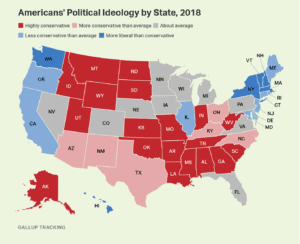 Nationally, the conservative advantage in ideological identification is nine percentage points, and reflects a narrowing of the conservative-liberal gap from 21 points in 2004.
Nationally, the conservative advantage in ideological identification is nine percentage points, and reflects a narrowing of the conservative-liberal gap from 21 points in 2004.
These findings are based on aggregated data from Gallup’s 2018 tracking poll in which respondents were asked to indicate whether they describe their political views as liberal, moderate or conservative.
States in which the conservative-liberal gap is 20 points or greater are considered “highly conservative.” The “more conservative than average” states have gaps of between 15 and 19 points. “About average” states’ residents prefer the conservative description by seven to 14 points, and those with gaps of zero to six points are considered “less conservative than average.”
The number of states in which more residents identify as liberal than as conservative is down slightly from nine in 2017. Many of the changes are within the margin of error for the state’s sample — states that barely tilted liberal in 2017 barely tilted conservative in 2018 — so it is unclear how meaningful these changes are.
Mississippi ranked as the most conservative state in 2018, with 50% of residents identifying as conservative and 12% as liberal, for a gap of 38 […]











